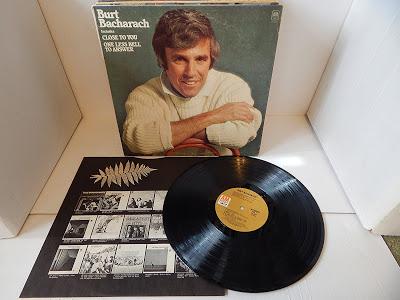by Paul J. Pelkonen
Burt Bacharach. © 1971 A & M Records.
Ever have one of those moments where music makes you travel back in time? That happened to me last night around 1am, when I sat down very late, put up my feet, put on my big headphones and listened to the 1971 record Burt Bacharach, the fourth studio album from the composer and arranger who has been part of this country's musical landscape for an amazing sixty-four years.When I was a kid, my late grandmother had a copy of that album, tucked with all her other LPs into the large, dark credenza that stood at the head of her dining room table. And she also had a stereo, an enormous wooden cabinet of curiosities where you opened doors for access to the record player and the amplifier, seated proudly in the front of her Bay Ridge home at the end of 78th St. And the album I connected with, the first LP to help me find my inner love of music was...Burt Bacharach.
I had forgotten about this album, except that some of the songs lived on in my subconscious, written there due to repeated plays at this very early age. I rememebered the opening "Mexican Divorce," (a song that was written for The Drifters--and which worried my mother when she heard me singing the chorus in the car ride home!) the mellow, jazzy of "Hasbrook Heights" (sic), and the big six-minute arrangements of "Wives and Lovers," which was probably the first time I ever heard a theme-and-variations. Beethoven was still a bit beyond me.
There was a semi-sung version of "(They Long to Be) Close To You", a song I knew from The Carpenters and that they had us sing in school music class. And there was "All Kinds of People," a plea for unity with a great horn solo. My favorites were the big experimental jazz tracks, "Freefall," the cinematic "And the People Were With Her" and the album closer, a soaring version of "One Less Bell to Answer" sung by Cissy Houston (mother of the late Whitney.) I always found that one "vaguely upsetting" as a kid.
Of course I didn't know these songs were experimental jazz, but I did learn not to talk about how much I loved the album when a neighborhood kid I was friends with told me how "lame" "Wives and Lovers" was. Bullies. I never listened to the album again. I wanted to be cool. I also learned as a kid in Brooklyn not to discuss music, a discretion that was valuable if you grew up going to school in Bay Ridge but were looked at as an "other" kid because you lived in Sunset Park, at the time quite literally the wrong side of the subway tracks.
Cut to 2016. We were in Connecticut visiting my partner's family. On the Saturday after Thanksgiving, her brother-in-law took me to Redscroll Records in Wallingford, a great little record store specializing in vinyl, rock and roll but not much, alas in the way of classical music. Flipping through the bins in search of holiday presents for this vinyl-loving family I ran across a familiar album cover, Burt himself posing on a chair in a white cable-knit sweater and open-necked shirt. And the memories of this record and these songs flooded back all at once.
Burt Bacharach's music has always been in my life to one degree or another, from his contributions to the jazz-lounge genre to the 1990s revival that saw him collaborate with Elvis Costello and appear as himself (three times!) in the Austin Powers movies. I even saw him at a Knick game once. And in my jazz phase in the 1990s, I bought Stan Getz' What the World Needs Now and quietly, discreetly enjoyed it. However, Saturday's encounter with Burt Bacharach led me to buy myself a digital copy of the record, as I don't have an LP player. I also did a little research, discovering songs that I didn't know were written by him, from 1962's "(The Man Who Shot) Liberty Valance" all the way up to "Always Something There (To Remind Me)" a solitary hit in 1983 for new-wave duo Naked Eyes.
Listening to Burt Bacharach was more than just an exercise in nostalgia. I heard these ten songs with an adult's ears. I recognized elements that I loved as a child but now understood what made them work. The way Bacharach arranged strings, winds and flugelhorn to hypnotic effect, undercut with his own piano and a jazzy wash of cymbals. The piano, panned all the way to the right stereo speaker on "Wives and Lovers", so it could dialog with the big band. And the final "One Less Bell to Answer" now soared, a soulful, sorrowful song with the power of an opera aria and some similarity in the arrangement. As it ended I realized I owe this man a debt for opening my ears at an early age.


